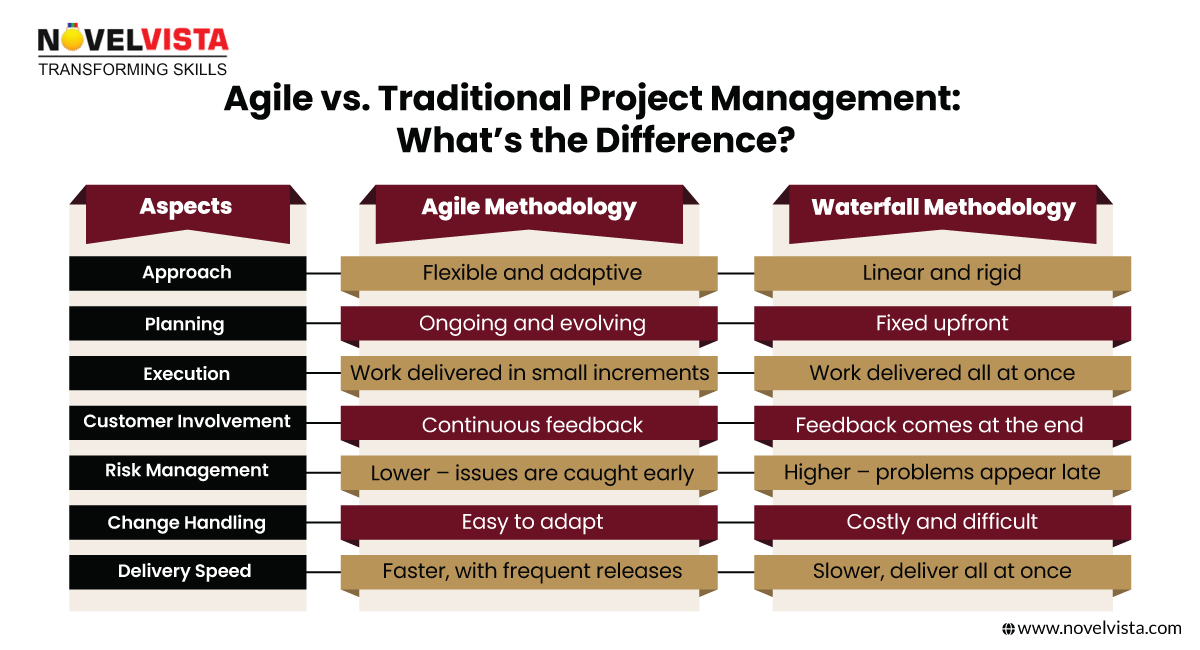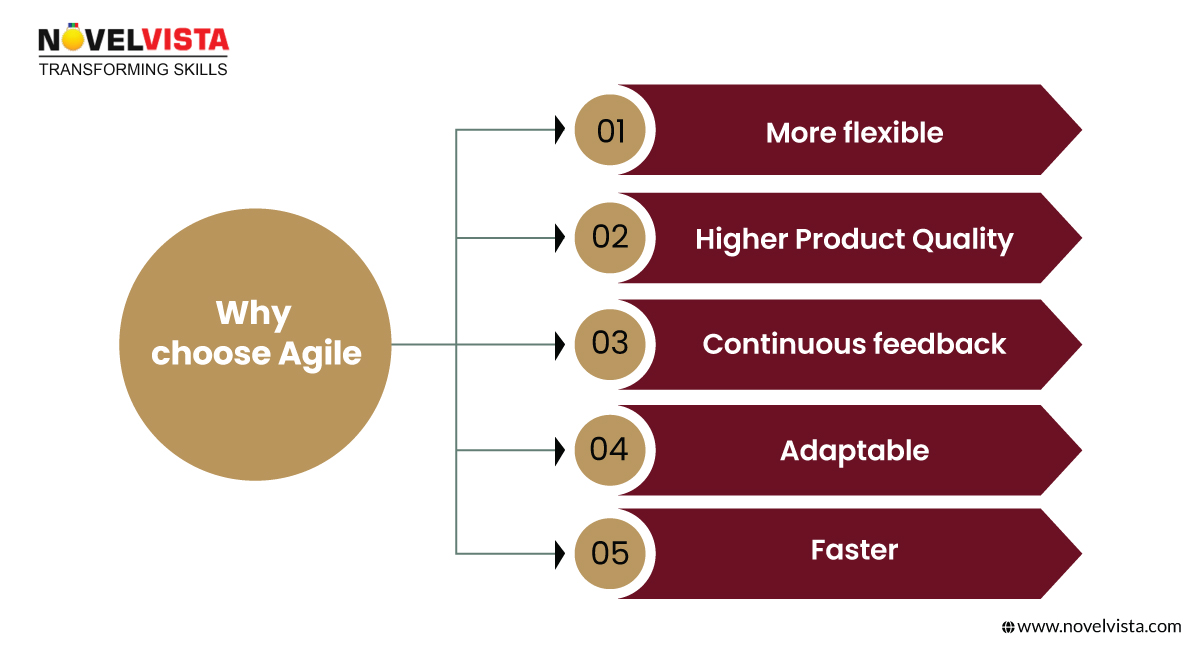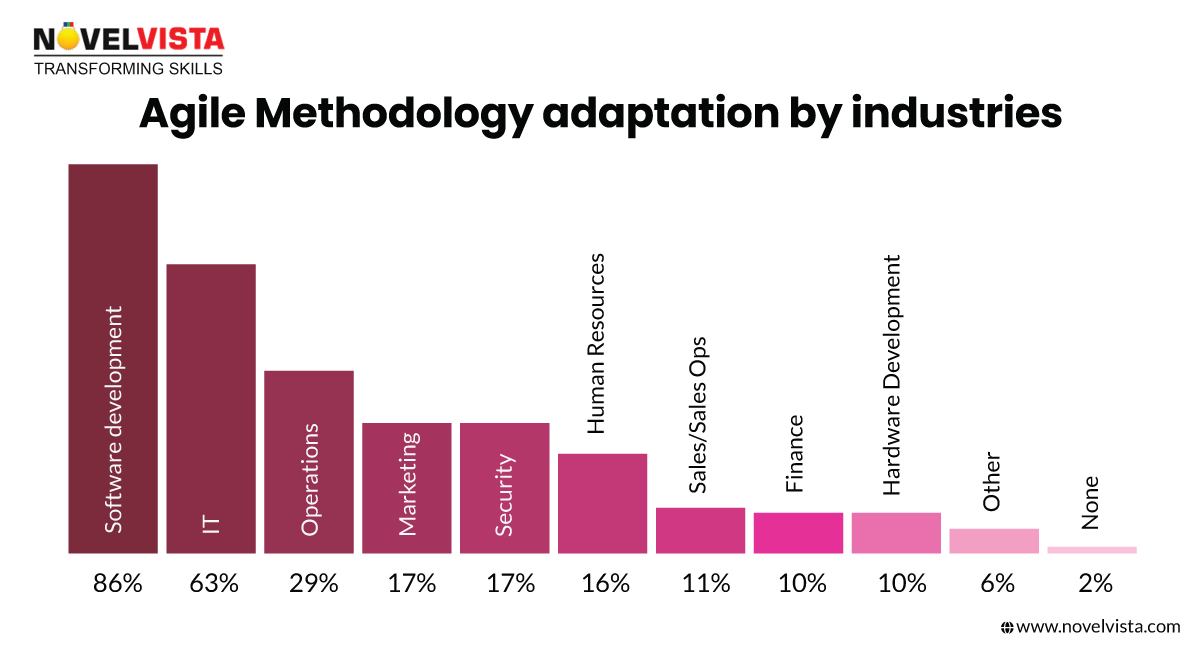Ever feel like traditional project management is too slow to keep up with today’s fast-paced world? Agile Methodology has the solution for this! It’s all about flexibility, teamwork, and delivering value quickly. Agile doesn't follow traditional, rigid, step-by-step approaches. Instead, it does:
If you’re ready to master Agile, check out AgileScrum master trainingand take your skills to the next level!
Agile might feel like a whole new world if you're used to Waterfall project management. Here’s how they compare:


Want real-world examples? Check out real-world agile case studies to see Agile in action!
You might wonder about theAgile developmentworking mechanism. Agile isn’t just one method—it’s a mindset that comes in different frameworks, each with its distinctive spin. One of the most popular? Scrum!
Want to explore more Agile methods? Check outAgile methodologiesfor a deep dive!
Agile isn’t for every project. However, it is a table-turner when used in the exact situations.
Done right, Agile can completely transform the way your team works!
Whenever we talk about Agile, you must feel like asking this question.
Remember the time when a new, good-looking student just got shifted to your school from some different high school due to his father’s transfer? That new peep always had way around with all of your classmates, they’d tell you stories about the skills of the student. But you didn’t really believe in them till the time you saw that person in action with those skills. Isn’t that correct?
Well, that is the basic human nature. When it comes to technology, it’s the same. We don’t tend to trust technologies which we haven’t worked on or at least have seen some case studies where it has shown it’s efficiency. No matter how the blog represents them in the rose coated version, people who have experienced thorns of several technologies in their entire career, know the pain points of adopting new technology without any background check.
In the same way, we too have spread good words about Agile in ourprevious blog“A for Agile: The new ABC’s in the industry”. But, we are pretty sure that you’d love to see some numbers regarding that.
Hence, in this blog, we are going to give you some real-life examples of an agile environment and how agile helped to overcome the crisis. Make sure to leave a comment if you have got any queries for us!
According to an article bybetanews.com:
“97% of firms have started with their Agile methodology practices in 2019” |
And those are just the organizations that belong to the IT industry. Agile can be used in other sectors too!
Before we start with the examples, let us go through the benefits of agile over the waterfall methodology to any organization once more!
No project runs 100% smoothly, but Agile problem resolution ensures problems are faced head-on.
By using Agile overcoming obstacles strategies, businesses stay resilient, efficient, and customer-focused!
Looking to build an unstoppable Agile team? Explore agile teams and see how collaboration drives success withNovelVista!
In ourprevious blogabout Agile, we talked about thebenefits and practicesof it in detail. Let’s review them once more as follows:
Since you have revised thebenefits of Scaled Agile Frameworkin the above-mentioned points, now let us move to the real-life scenarios.
As mentioned above, Agile is being used in so many organizations in various fields. That includesIT, banking, NGO, entertainment, and a lot more.
Surprised? let’s see how it is done. Here are some real-life scenarios where Agile became a true savior.
Using the Agile work modelis not anything new for IBM. They have been doing it for ages.
Fred Brook’s book “The Mythical Man-Month” explains all about how big projects in IBM got slower by time as more and more people were added. Brooks was the one to experiment with small teams way before the Agile manifesto came on board
The only department ofIBM was not following agile methodology, it was theirhuman resources department.
IBMwasfacing troublesinrecruiting and retaining top talent and performanceof the organization.
Hence, they too decided to have a taste of thebenefits of Agile methodology.
With thehelp of agile methodology, IBM started off by identifying their goals. After thegoal was defined, they created cross-functional, self-selected teams instead of the management-assigned team. This helped with employee empowerment. Now, who wouldn’t want to work with an organization that empowers its employees?
The teams implemented a backlog to manage their work in progress, which can create transparency and let the team focus on one particular task at a time. In this way, performance management was handled well.
For more than 8 years,Sky, the largest entertainment company in Europe, was using the same old classic method of define, design, and deliver. It was fine at the start, but after a few years, the employees started pointing out that particular process as slow to implement and too top-down.
Tracey Waters, Head of People Development and Communication,stated, “We felt there was a lot of waste in traditional learning and development in terms of time, effort and money."It wasn’t getting people what they needed when they needed it. We wanted to challenge ourselves to help the organization learn without resorting to traditional means, and we didn’t see digital as the whole answer.”
Hence, instead of following the traditional method and waiting for results, Tracey decided to find her resolutions in an agile way.
After switching to Agile,Tracey was able to divide the tasks into small units and distribute them to the entire team. Not only this, learners and managers were able to share the learner feedback, and problems were being solved as quickly as possible!
Lonely Planet is a travel book publisher organizationwhich was facing troubles with their legal team. Their internal clients failed to understand the nature of work and the workload and ended up giving unrealistic deadlines. This resulted in a day-to-day hectic schedule for employees along with the less amount of job satisfaction.
The lawyers involved with the legal department were not being able to take up interesting projects which will help the company grow and improve productivity.
Though the fast-paced work nature of Agile does not really fit with the legal work methods, this methodology helped the team to look at the process from an end to end perspective and made the way the work is delivered efficient enough.
After theimplementation of Agile methodology,the result was quite stunning
VistaPrint, a marketing companyfor small businesses evaluated its waterfall methodology and found out from the ideation phase to the product delivery phase, it takes 60 days for them to deliver the final output.
It is quite obvious that you won’t earn the level of customer satisfaction you are looking for if you maintain a lifecycle this long.
That is whyVistaPrint switched to Agile. And the output was beyond amazing.
There was no more room for unclear decisions, long-tail creative teams or feedback swirls. They began to promote team environments, information sharing, and transparency, implemented team building activities, daily stand-ups, Kanban boards, idea pipelines, more informational touchpoints, and retrospectives to review what went well and what didn’t to improve their processes for the future.
“In the next five months, they were surprised to see how the lifecycle cut down to 15 days.” |
Staffing Solutions, a struggling staffing agency, adopted Agile principles. They formed cross-functional "pods" with recruiters, sourcers, and account managers. Daily stand-up meetings improved communication. Weekly sprints with clear goals increased efficiency.
Regular client feedback and data analysis ensured continuous improvement. This led to: * Improved client satisfaction * Reduced time-to-fill * Enhanced candidate experience * Boosted employee morale * Gained a competitive edge
There was no more room for unclear decisions, long-tail creative teams or feedback swirls. They began to promote team environments, information sharing, and transparency, implemented team building activities, daily stand-ups, Kanban boards, idea pipelines, more informational touchpoints, and retrospectives to review what went well and what didn’t to improve their processes for the future.
Key Takeaway: Agile helped Talent Solutions become more responsive, efficient, and client-centric.
Don’t you think it’s amazing?
According to thereport, the following Industries have embraced Agile Methodology till now:

We can go on and on about agile methodologies. But it won’t be much help for you till the time you start working under an agile work model. Imagine a glass of normal-temperature water and a glass of cold mango juice is given to you on a summer day. Will you even bother looking at the normal water?
That’s the same with Agile. Once you are accustomed to working in an Agile environment, the classic waterfall model will always feel meh to you.
Confused about how to develop an agile environment? Maybe you can apply forourAgile and Scrum trainingto understand that! Do you have your own Agile stories to share with us too? Drop a comment! We are eagerly waiting to hear!
Confused about our certifications?
Let Our Advisor Guide You